
News |
- Lac-Mégantic Derailement - Crude Oil Train Cars Mislabelled
- Lake Ontario Experiences Dramatic Colour Change
- Manitoba, Ontario, Fund IISD to Operate ELA
- Elizabeth May: $120 Million 'Greases' Northern Gateway Bid
- Germany Closing Fossil Fuel Plants
- Ecological Debt Day Reached
- Nestle Bottled Millions of Litres of Water Without Paying
- Neonicontinoids: New 'DDT' Killing Bees and Natural World
- TransCanada Pipeline Coming to Manitoba
- ForestEthics Sues Canada Over Freedom of Expression
- Detroit Mayor Orders Pet Coke Piles Removed
- Steam Extraction Methods for Oilsands Need Inquiry
| Lac-Mégantic Derailement - Crude Oil Train Cars Mislabelled | 13 September 13 |

Source thestar.com
Petroleum crude oil is categorized as a Class 3 Dangerous Good, and can be divided into three packing groups, depending on the level of safety hazard. The oil on the Lac-Mégantic train was identified for transportation from North Dakota as Packing Group III, the least hazardous in that class. The TSB said the crude oil that was transported by Montreal, Main & Atlantic Railway was documented as a Class 3 Dangerous Good (flammable liquid), group 3, when it should have been classified as a more volatile group 2 product. Officials with the TSB said the classification impacts what kind of container the product is shipped in. "The lower flash point of the crude oil explains in part why the crude oil ignited so quickly once the Class 111 tankers were breached," TSB investigator Don Ross said in an interview September 11, 2013. Ross said the TSB investigation into the derailment is ongoing. The TSB investigation has previously said that a lack of adequate braking onboard the train could have caused the derailment. View September 11, 2013 Financial Post articleView September 11, 2013 Toronto Star article View September 11, 2013 CTV News article View September 11, 2013 The Globe and Mail article |
|
 Print version Print version |
Top |
| Lake Ontario Experiences Dramatic Colour Change | 6 September 13 |
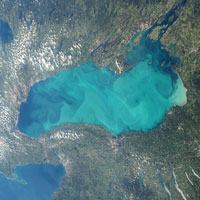
Source: CBC News
Biologist Michael Twiss of Clarkson University explained the process that occurred, known by scientists as a "whiting effect". A spike in recent temperatures caused mass photosynthesis by microorganisms in the lake, which in turn led to a rise in the water's pH. With the high pH in the lake, chemical reactions took place where the naturally occurring calcium and carbonate ions created white specks of calcite - responsible for the lake's exotic colour. Twiss stated that in recent years, this phenomenon had become increasingly rare, although before the arrival of invasive zebra mussels in the 1990's, it was a common occurrence. Picocyanobacteria, the species of microorganism dominant in this whiting effect, creates non-harmful algal blooms that should not be confused with dangerous blue-green algal blooms, as was initially feared by scientists witnessing this phenomenon. View September 3, 2013 CBC News article |
|
 Print version Print version |
Top |
| Manitoba, Ontario, Fund IISD to Operate ELA | 6 September 13 |
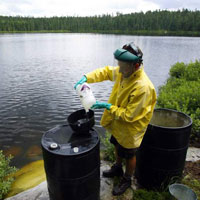
Source: Winnipeg Free Press
"The ELA will be invaluable to helping us solve the complex issues surrounding the health of Lake Winnipeg and basin waterway challenges," said Selinger. "Stable long-term funding is critical for the nationally and internationally important work that is conducted at this facility." Over a six-year process, a $6 million agreement, involving the Governments of Manitoba and Ontario, will ensure that the world-renowned freshwater research station remains in operation, despite major setbacks brought about by federal budget cuts to the Department of Fisheries and Oceans in March 2013. The IISD, a 20 year-old Winnipeg-based institute, conducts research regarding development of a sustainable management strategy for the Lake Winnipeg South Basin. Management of the research site will eventually be passed over fully to the IISD. View September 2, 2013 CBC News articleView September 2, 2013 Government of Manitoba news release View May 10, 2013 Manitoba Wildlands news item |
|
 Print version Print version |
Top |
| Elizabeth May: $120 Million 'Greases' Northern Gateway Bid | 6 September 13 |
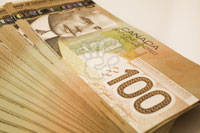
May says the Harper government is spending at least $78 million on marine spill studies specifically connected to bitumen, the molasses-like crude that would be shipped in the pipeline between Alberta and British Columbia. Also the documents reveal Ottawa is spending $42 million to study ways to improve weather forecasting in the northern B.C. coastal regions that will be used by oil tankers if the project is approved by the federal Joint Review Panel. "Some of this money is going to backfill for Enbridge and do the homework it should have done before it went to the Joint Review Panel," said May. "Other money is operational and represents an investment in better weather forecasting for supertanker routes that don't exist yet. We're building an infrastructure as though the project is already approved." View September 5, 2013 Huffington Post articleView September 4, 2013 CBC News article View September 4, 2013 CTV News article View September 4, 2013 The Vancouver Sun article View September 4, 2013 The Province article |
|
 Print version Print version |
Top |
| Germany Closing Fossil Fuel Plants | 6 September 13 |

In a statement released by RWE the company said; 'Due to the continuing boom in solar energy, many power stations throughout the sector and across Europe are no longer profitable to operate. During the first half of 2013, the conventional power generation division's operating result fell by almost two-thirds.' RWE's German rival, E.On has also said it has shut down or left idle 6.5 GW of generating capacity. As fossil fuels show signs of decline in Germany, the country's record-breaking renewables sector continues to grow stronger. View September 6, 2013 SolarServer articleView September 5, 2013 SmartGridNews article View September 5, 2013 The Guardian article View September 4, 2013 CleanTechnica article View August 22, 2013 TckTckTck article View August 14, 2013 BBC News article View August 14, 2013 RWE bews release View August 14, 2013 The Telegraph article |
|
 Print version Print version |
Top |
| Ecological Debt Day Reached | 23 August 13 |

In 1993, Ecological Debt Day fell on October 21. In 2003, Ecological Debt Day was on September 22. Given current trends in consumption, one thing is clear: Ecological Debt Day arrives a few days earlier each year. "It is like having a bank account," Juan Carlos Morales of the independent think tank Global Footprint Network told Common Dreams. "If you don't have money available, you have to take out credit. We are depleting resources faster than Earth can regenerate." Throughout most of history, humanity has used nature's resources to build cities and roads, to provide food and create products, and to absorb our carbon dioxide at a rate that was well within Earth's budget. In the mid-1970s, we crossed a critical threshold. Human consumption began outstripping what the planet could reproduce. View August 20, 2013 Common Dreams articleView August 20, 2013 Rabble.ca article View September 25, 2009 The Guardian article View World Wildlife Fund Ecological debt day page View Global Footprint Network Earth Overshoot Day page |
|
 Print version Print version |
Top |
| Nestle Bottled Millions of Litres of Water Without Paying | 23 August 13 |

B.C.'s lack of groundwater regulation allows Nestlé Waters Canada, a division of Switzerland-based Nestlé Group, the world's largest food company not to measure, report, or pay a penny for the millions of litres of water it draws from wells and sells back to Canadians in Western Canada. Grand Chief Stewart Phillip, president of the Union of B.C. Indian Chiefs, says First Nations continue to be ignored by both provincial and federal governments despite a legal right to be consulted on all small- and large-scale resource development projects, whether it's groundwater extraction or fracking in northeastern B.C. "They don't want indigenous rights and interests to stand in the way," Phillip said. "Before even moving ahead with a plan, the law dictates that we need to be consulted at the outset. It's not optional." View August 22, 2013 The Vancouver Sun articleView August 16, 2013 The Globe and Mail article View August 14, 2013 Canada.com article View June 27, 2013 GlobalResearch article View June 3, 2013 CBC News article View October 18, 2012 Canada.com article |
|
 Print version Print version |
Top |
| Neonicontinoids: New 'DDT' Killing Bees and Natural World | 23 August 13 |

They are found in nectar and pollen of treated crops. Levels in soils, waterways, plants on field borders overlap with concentrations that are sufficient to control pests in crops. These concentrations commonly exceed a safe concentration and kill 50% of other insect pollinators, and impact local wildlife. Concentrations in nectar and pollen in crops are sufficient to impact substantially on bumblebee colonies. The studies that have been published show neonicotinides can last in the soil and environment for roughly nineteen years. This means the toxicity level of the presence of neonicotineds is likely to only become worse. The corporations that make these toxins, have claimed they were harmless to species other than the pests they targeted, as was claimed for DDT. People who have raised concerns, are being threatened, as was done in the days of rampant DDT usage. View 2013 University of Stirling reportView August 5, 2013 The Guardian article View April 28, 2013 The Guardian article View United States Environmental Protection Agency DDT page View DDT - Wikipedia Entry |
|
 Print version Print version |
Top |
| TransCanada Pipeline Coming to Manitoba | 23 August 13 |
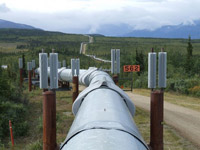
TransCanada is calling its pipeline project the Energy East Pipeline. It is a planned 4,500-kilometre pipeline that is supposed to carry 1.1-million barrels of bitumen and crude oil per day from Alberta and Saskatchewan to refineries in Eastern Canada. A major component of this project includes converting an existing natural gas pipeline to an oil transportation pipeline, which as past events have already demonstrated, is clearly not a safe option. Quebec and potentially Ontario have decided to conduct an environmental review and assessment of the project. Below is a list of the remaining Manitoba Open Houses.
View Energy East Open Houses View August 22, 2013 The Guardian article View August 6, 2013 CBC Radio article View July 29, 2013 The Hill Times Online article View July 13, 2013 Toronto Star article |
|
 Print version Print version |
Top |
| ForestEthics Sues Canada Over Freedom of Expression | 16 August 13 |

The application, filed in Toronto August 13th, calls for the Federal Court of Canada to strike down provisions of the National Energy Board Act that unreasonably restrict public comment on project proposals. ForestEthics Advocacy and Ms. Sinclair are also challenging new NEB rules, which prevent any discussion of the wisdom of tar sands development at the upcoming Enbridge Line 9B hearings. The National energy Baord (NEB) regulates the oil, gas, and electricity industries and approves pipeline construction, coal and uranium mining, liquified natural gas projects, and tar sands development in Canada. Its decisions have massive environmental and health implications, especially for projects that cross provincial or international borders. Under the new rules, many Canadians are blocked from participation. "Through legislative changes snuck into last year's Omnibus Budget Bill C-38, the Conservative government has undermined the democratic rights of all Canadians to speak to the issues that impact them," explained Mr. Ruby. "Right now, they cannot question the development of the tar sands itself! We're challenging the legislation and the NEB's new rules because they violate fundamental free speech guarantees enshrined in the Canadian Charter of Rights and Freedoms." View August 13, 2013 ForestEthics press releaseView August 13, 2013 The Globe and Mail article View August 13, 2013 Treehugger article View August 10, 2013 The Globe and Mail article |
|
 Print version Print version |
Top |
| Detroit Mayor Orders Pet Coke Piles Removed | 16 August 13 |
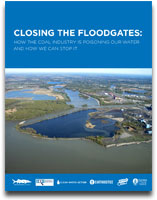
The piles of pet coke are causing air and water contamination concerns for local residents, are owned by Koch Carbon. The property where the pet coke is stored is owned by controversial billionaire and Ambassador Bridge owner Manuel Moroun and leased to Norfolk Southern railroad. The Ambassador Bridge links Detroit and Windsor, Ontario. In a statement issued Tuesday, August 13, Mayor Bing said Detroit Bulk Storage failed to remove all of the pet coke by Aug. 9, "as directed by a Correction Order issued by the City's Buildings, Safety Engineering and Environmental Department." The department cited Detroit Bulk Storage for being in violation of the Detroit property maintenance code and/or official zoning ordinance. Mayor Bing has now ordered the pet coke be removed by Aug. 27. Recently winds have caused clouds of pet coke from the piles stored in Detroit to blow across the Detroit River into Canada. View August 14, 2013 CBC News articleView May 2013 PolicyMic article View August 14, 2013 Huffington Post article View August 15, 2013 Examiner article View Closing the Floodgates report |
|
 Print version Print version |
Top |
| Steam Extraction Methods for Oilsands Need Inquiry | 16 August 13 |

Source: pipe-up.net
About half of current oilsands production comes from in-situ methods that pump steam deep underground to soften the tarry bitumen and enable it to flow through to the surface. The in-situ method will eventually account for about 80 per cent of oilsands extractions, said Carolyn Campbell, of the Alberta Wilderness Association. "It is time for a broader discussion of the safety and regulation of steam injection given these recurring events," said Greenpeace campaigner Mike Hudema said in a news release. "The AER needs to reassure the Alberta public and other stakeholders that it has the regulations in place to prevent similar incidents from occurring in the future." The CNRL site has been leaking for three months. View August 13, 2013 Global News articleView August 13, 2013 Yahoo! News Canada article View August 10, 2013 Edmonton Journal article View August 8, 2013 Global News article View July 30, 2013 Huffington Post article |
|
 Print version Print version |
Top |


 RSS Feeds:
RSS Feeds: